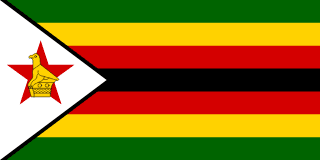Zimbabwe - Economy

How is the economy of Zimbabwe? Based on the information we have, Zimbabwe has a low income Sub-Saharan economy; political instability and endemic corruption have prevented reforms and stalled debt restructuring; new Zimbabwe Gold (ZiG) currency latest effort to combat ongoing hyperinflation; reliant on natural resource extraction, agriculture and remittances. Key agricultural products in this country include: sugarcane, beef, maize, cabbages, potatoes, tomatoes, milk, onions, bananas, wheat (2023).
More about the economy of Zimbabwe
| Labor force | 6.386 million (2024 est.) |
|---|---|
| Industrial production growth rate | 2.7% (2024 est.) |
| Industries | mining (coal, gold, platinum, copper, nickel, tin, diamonds, clay, numerous metallic and nonmetallic ores), steel, wood products, cement, chemicals, fertilizer, clothing and footwear, foodstuffs, beverages |
| Population below poverty line | 38.3% (2019 est.) |
| Taxes and other revenues | 7.2% (of GDP) (2018 est.) |
| Fiscal year | |
| Exchange rates | |
| Currency | Zimbabwean dollars (ZWD) per US dollar - |
| Exchange rates 2024 | 3,266.332 (2024 est.) |
| Exchange rates 2023 | 3,509.172 (2023 est.) |
| Exchange rates 2022 | 374.954 (2022 est.) |
| Exchange rates 2021 | 88.552 (2021 est.) |
| Exchange rates 2020 | 51.329 (2020 est.) |
| Debt - external | |
| Debt - external 2023 | $6.671 billion (2023 est.) |
| Reserves of foreign exchange and gold | |
| Reserves of foreign exchange and gold 2024 | $484.973 million (2024 est.) |
| Reserves of foreign exchange and gold 2023 | $115.53 million (2023 est.) |
| Reserves of foreign exchange and gold 2022 | $598.622 million (2022 est.) |
| Current account balance | |
| Current account balance 2023 | $133.877 million (2023 est.) |
| Current account balance 2022 | $304.966 million (2022 est.) |
| Current account balance 2021 | $348.215 million (2021 est.) |
| Public debt | |
| Public debt 2016 | 69.9% of GDP (2016 est.) |
| Budget | |
| Revenues | $17 million (2018 est.) |
| Expenditures | $23 million (2018 est.) |
| Budget surplus (+) or deficit (-) | |
| Remittances | |
| Remittances 2023 | 9.4% of GDP (2023 est.) |
| Remittances 2022 | 9.4% of GDP (2022 est.) |
| Remittances 2021 | 9.4% of GDP (2021 est.) |
| Household income | |
| Lowest 10% | 2.5% (2017 est.) |
| Highest 10% | 34.8% (2017 est.) |
| Imports | |
| Imports 2023 | $10.293 billion (2023 est.) |
| Imports 2022 | $9.569 billion (2022 est.) |
| Imports 2021 | $8.104 billion (2021 est.) |
| Imports (partners) | South Africa 37%, China 15%, Bahamas, The 5%, Singapore 5%, UAE 4% (2023) |
| Comodities Imports force | refined petroleum, fertilizers, trucks, soybean oil, stone processing machines (2023) |
| Exports | |
| Imports 2023 | $10.293 billion (2023 est.) |
| Imports 2022 | $9.569 billion (2022 est.) |
| Imports 2021 | $8.104 billion (2021 est.) |
| Exports (partners) | UAE 45%, China 18%, South Africa 15%, Mozambique 4%, Hong Kong 2% (2023) |
| Comodities Exports force | gold, tobacco, nickel, minerals, diamonds (2023) |
| Real GDP (purchasing power parity) | |
| Real GDP (purchasing power parity) 2024 | $57.391 billion (2024 est.) |
| Real GDP (purchasing power parity) 2023 | $56.249 billion (2023 est.) |
| Real GDP (purchasing power parity) 2022 | $53.399 billion (2022 est.) |
| GDP (official exchange rate) | $44.188 billion (2024 est.) |
| Real GDP Per capita | |
| Real GDP per capita 2024 | $3,500 (2024 est.) |
| Real GDP per capita 2023 | $3,400 (2023 est.) |
| Real GDP per capita 2022 | $3,300 (2022 est.) |
| GDP - composition, by sector of origin | |
| Agriculture | 5.4% (2024 est.) |
| Industry | 31.8% (2024 est.) |
| Services | 55.8% (2024 est.) |
| GDP - composition, by end use | |
| Household consumption | 91.5% (2024 est.) |
| Government consumption | 12.5% (2024 est.) |
| Investment in fixed capital | 3.6% (2024 est.) |
| Investment in inventories | 0.9% (2024 est.) |
| Exports of goods and services | 22.1% (2024 est.) |
| Imports of goods and services | -30.6% (2024 est.) |
| Unemployment rate | |
| Unemployment rate 2024 | 8.6% (2024 est.) |
| Unemployment rate 2023 | 8.8% (2023 est.) |
| Unemployment rate 2022 | 10.1% (2022 est.) |
| Youth unemployment rate (ages 15-24) | |
| Total | 14% (2024 est.) |
| Male | 12.9% (2024 est.) |
| Female | 15.4% (2024 est.) |
All Important Facts about Zimbabwe
Want to know more about Zimbabwe? Check all different factbooks for Zimbabwe below.









